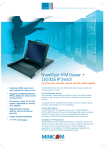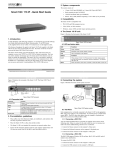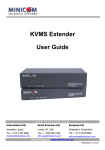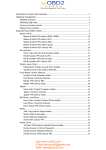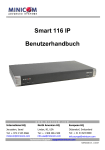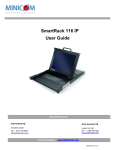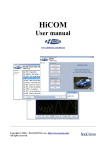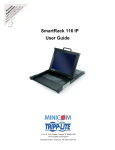Download Minicom Advanced Systems SMARTRACK 116 IP User guide
Transcript
SMARTRACK 116 IP SmartRack 116 IP - Quick Start Guide QUICK START GUIDE 1. Introduction 3. Hardware kit contents To take advantage of the full range of features, we recommend you read the softcopy User Guide after performing the Quick Start procedure. It’s in PDF format on the supplied CD or on our website www.minicom.com in the Support section. Rail with front and rear bracket x 2, for rack depth of 614 ~ 800 mm. Right and left sides are different. The SmartRack 116 IP extends your KVM (keyboard, video, and mouse) from any computer or server over TCP/IP via LAN, WAN or Internet connection. Now you can control, monitor and manage up to 16 remote servers from wherever you are, inside or outside the organization. The SmartRack 116 IP is a cost-effective hardware solution, for secure remote KVM access & control of 16 computers/servers from the BIOS level - independent of the OS. One local analog or one remote digital IP user can access and control 16 multi-platform (PS/2, SUN, USB) servers at a time. Screws x4 Keys x 2. 4. Pre-installation guidelines Long bracket x 2. (For increased rack depth of 905 ~ 990mm) Occupying just 1U of rack space, it’s the neat, space-saving way to control your data rack. It comes with all the hardware you need to mount it, and is easy to install. To access servers, just slide out the drawer and flip up its top to display the large, high resolution 17” TFT LCD display. The display is (VGA/SVGA/XGA/SXGA compatible) with front-panel highquality controls and Touchpad for easy adjustment. SMARTRACK 116 IP • Switch off all computers • Place cables away from fluorescent lights, air conditioners, and machines that are likely to generate electrical noise • Ensure that the maximum distance between each computer and the SmartRack 116 IP does not exceed 30m/100ft 5. Connecting to a rack Note! For increased rack depth of 800 ~ 990mm, first change the bracket to the medium or long bracket, see section 5.1 on page 6. Note! The illustrations below show the connections to one side of the SmartRack 116 IP. The connections are the same for the other side. Medium bracket x 2. (For increased rack depth of 800 ~ 905mm) 1. Move the rail until two screws appear, see Figure 1. 1.1 Compatibility The SmartRack 116 IP is compatible with: • PS/2, SUN and USB computers/servers • Windows, Linux, UNIX and other major operating systems Short bracket x 2 Figure 1 Exposing the 2 screws 2. System components 2. Loosen slightly the 7 screws as shown below. The SmartRack 116 IP system consists of: • 1 SmartRack 116 IP • 1 RS232 Download cable (p/n 5CB40419) • ROCS - PS/2, USB. (Ordered separately). CAT5 cables (1.5m provided) Bracket attachment x 2 Note! The short bracket and bracket attachment for a rack depth of 504~ 614 mm and without a KVM switch connected to the drawer. Flat screws x 6 (for rail mount to console body) Screws x 6 Figure 2 Loosen 7 screws 3. Adjust the rear bracket to fit your cabinet, see below. Technical support - [email protected] © 2009 Copyright Minicom Advanced Systems. All rights reserved. 5UM21182 V1 12/09 QUICK START GUIDE Bracket A with thumbscrew x 2 1 2 3 SMARTRACK 116 IP QUICK START GUIDE SMARTRACK 116 IP Figure 12 Taking the rear bracket out Figure 3 Adjusting the bracket 4. Install the front and rear bracket onto the cabinet, see figure below. Figure 6 Sliding the SmartRack between the rails 8. Unlock and pull both left and right rail–lock switches together – see below – and push the console all the way into the rack. Figure 9 Console in the rack 5.1 Using the medium or longer bracket For a rack depth of 800 ~ 905mm, use the medium bracket. For a rack depth of 905 ~ 990mm, use the longer bracket. 3. Insert the medium/long bracket into the rail then adjust the bracket to fit your cabinet. 4. Tighten at least 2~3 screws along the length you need. Note! For medium bracket use the round screws screws , and for the long bracket use the flat .See Figure 13. To replace the bracket with the medium or longer bracket: 1. Loosen the 7 screws as shown below. Figure 4 Installing front and rear bracket on cabinet 5. Tighten the 7 screws as shown below. Figure 13 Inserting and tightening the long bracket 5. Repeat the above steps for the other side. Figure 7 Rail–lock switch 9. Connect three flat screws to the rear of the console on both sides. See figure below. Figure 10 Loosening the 7 screws Remove the six (different) screws as shown below. 6. Go to section 5 Connecting to a rack. 5.2 Connecting the KVM Switch 116 IP 1. Connect the bracket A to the sides of the Switch using the two 6mm screws provided see figure below. Figure 5 Tightening the 7 screws 6. Repeat the steps above to connect the other rail to the other side of the rack. 7. Slide the SmartRack console between the rails as shown below. Figure 8 Connecting three flat screws to the rear of the console The console now sits snugly in the rack, see Figure 9. Figure 11 Removing the six screws 2. Take the rear bracket out, see below. Figure 14 Connecting the bracket A to the sides of the Switch 4 5 6 7 QUICK START GUIDE SMARTRACK 116 IP 2. Slide the Switch 116 IP into the rail and into the back of the SmartRack console until you hear a click. See the figure below. QUICK START GUIDE 6. The SmartRack Switch system configuration You connect servers to the 116IP switch via ROCs. Figure 17 illustrate the basic configuration of the 116IP system. SMARTRACK 116 IP 7. Initial settings - Default IP address 6.2 Connecting ROCs to servers Each computer/server is directly connected to the SmartRack switch via the appropriate ROC using CAT5 cable in a star configuration. No external power is needed at the remote ROCs. The ROCs draw their power from the computer’s keyboard port (ROC PS/2) or from the USB port (ROC USB). 6.2.1 Connecting a ROC PS/2 You can connect the ROC PS/2 to a powered on computer, but it must be in the following order: MINICOM SERIAL SMARTRA CK 116IP SWI TCH FLASH LAN 9 10 11 12 13 14 15 16 1 2 3 4 5 6 7 8 1. Connect the Mouse connector to the computer’s Mouse port. SMARTRACK 116IP SWITCH Figure 15 Slide switch into back of SmartRack 3. Secure the Switch 116 IP to the rail by inserting the thumbscrews through the bracket and into the rail and tightening them, see Figure 16. 2. Connect the Keyboard connector to the computer’s Keyboard port. CAT5 cables Up to 30M / 100ft User over IP Internet / VPN / LAN 3. Connect the Screen connector to the computer’s Video port. Failure to connect in the above order while the server is running, may lead to the mouse malfunctioning until the server is rebooted. To servers 6.2.2 Connecting a ROC USB ROCs to servers Figure 17 SmartRack 116IP Switch system configuration 6.1 The 116 switch The ROC USB supports Windows 98 SE and later, MAC, SUN, SGI and all modern Linux distributions. To connect the ROC USB: 1. Connect the Screen connector to the computer’s Video port. 2. Connect the USB connector to the computer’s USB port. Figure 16 Tightening the thumbscrews MINICOM SERIAL 9 10 11 12 13 14 15 16 LAN 1 2 3 4 5 6 7 8 FLASH Flash LAN (Ethernet) (download) connector connector Server ports Connect the network cable to the LAN port. This must be done before powering on the SmartRack 116IP Switch. Power connector Figure 18 116IP Switch ports 6.1.1 Connector table Connector Function Serial This port is for future Serial functionality Flash To update firmware of the analogue part of the 116 IP Switch system - OSD, Switch, ROCs. LAN Connect to 10/100 Mbit Ethernet. Green LED illuminates when unit is connected to a 100 Mbit/sec network. Yellow Led illuminates when unit is connected to a 10 Mbit/sec network. Server ports Connect to servers via ROCs 8 QUICK START GUIDE 4. Press Enter. The Web interface opens at the Network Configuration page, see Figure 19. By default, SmartRack 116 IP boots with an automatically assigned IP address from a DHCP (Dynamic Host Configuration Protocol) server on the network. The DHCP server provides a valid IP address, gateway address and subnet mask. To identify the IP address, the SmartRack 116 IP MAC address appears on the underside of the SmartRack 116 IP box. The device number (D.N.) can also be found there. If no DHCP server is found on the network, SmartRack 116 IP boots with the static IP address:192.168.0.155. Note! If a DHCP server later becomes available, the unit picks up the IP settings from DHCP server. To keep the static IP address, disable DHCP – explained in the softcopy User Guide. 7.1 Static IP addresses for a number of units Where you want to connect more than 1 SmartRack 116 IP to the same network and there is no DHCP server, or you want to use static IP addresses, do the following: Connect the SmartRack 116 IP units one at a time and change the static IP address of each unit before connecting the next unit. 8. Logging into the Web interface 6.3 Connecting to the network SMARTRACK116IP SWITCH The following sections provide instructions for setting the IP address for the SmartRack 116 IP unit. 6.4 Connecting the CAT5 cables Client computer operating system. - Windows 2000 or higher, with Firefox 3 or Internet Explorer 7.0 or later version. Linux with Firefox 3. Complete the initial setup via the Web configuration interface: 1. Connect one connector to the ROC’s RJ45 port. 2. Connect the other connector to one of the SmartRack Switch Server ports. 1. Open your Web browser and type the SmartRack 116 IP system IP address https://IP address/ - and press Enter. The login page appears. 3. Follow the above 2 steps for each computer. 2. In mode select Configuration mode.. 6.5 Connecting the power supply 1. Connect the switch to the power supply using the Power cord provided. Only use the Power cord supplied with the unit. 3. Type the default Administrator user name admin and password access (both lower case). 2. Power on the switch. 9 10 11 SMARTRACK 116 IP QUICK START GUIDE SMARTRACK 116 IP 9.1.2 Selecting a computer 10. Starting a remote session To select a computer: 1. Navigate to the desired computer line. Or, type the port number of the desired computer. 2. Press Enter. The selected computer is accessed. A confirmation label appears showing which computer is accessed. Note! When the OSD is displayed you cannot select computers using the keyboard hotkeys. Figure 19 SmartRack 116 IP Web interface At a Client computer open the web browser and type the SmartRack 116 IP’s IP address. https://IP address. The Login page appears. Type your username and password and press Enter. By default, the user name is: admin and the password is access, (both lower case). Note! There is a shortcut to the Configuration pages from the login page. In mode you can toggle between the option to access a remote session or the configuration pages. To display the OSD: 1. Ensure there is no remote user connected. To disconnect the remote user press the Local button on the SmartRack 116 IP. 2. Press Shift twice. The OSD Main window appears. See Figure 20. Lines with yellow text show active computers. Lines with blue text show inactive computers. The Type column indicates a computer “C” is connected to the port. Session Profile Video Settings Keyboard Settings Power Control Settings (Currently not operational) 10.1 Switching to a different server/device To connect to a different server/device: 1. From the Toolbar, click . 2. Click the desired server. The screen of the server appears. . A list of connected servers/devices appears. To complete the initial setup and log into the web interface please see the softcopy User Guide on the supplied CD or on our website www.minicom.com in the Support section. C=computer Instruction keys Figure 20 OSD Main window 9.1.1 Navigating the OSD To navigate up and down use the Up and Down arrow keys. Figure 21 Remote console window To exit the OSD or return to a previous window within the OSD press Esc. 12 13 14 Disconnect Session Target Switching Menu Server name To jump from one column to the next (when relevant) use the Tab key. Full Screen Mode Figure 22 Toolbar icons Toolbar Port number appears here Mouse Settings When connecting you will download the Java client.. The screen of the currently selected Target Server with Minicom toolbar appears see Figure 21. 9. The OSD Locks Toolbar 15


